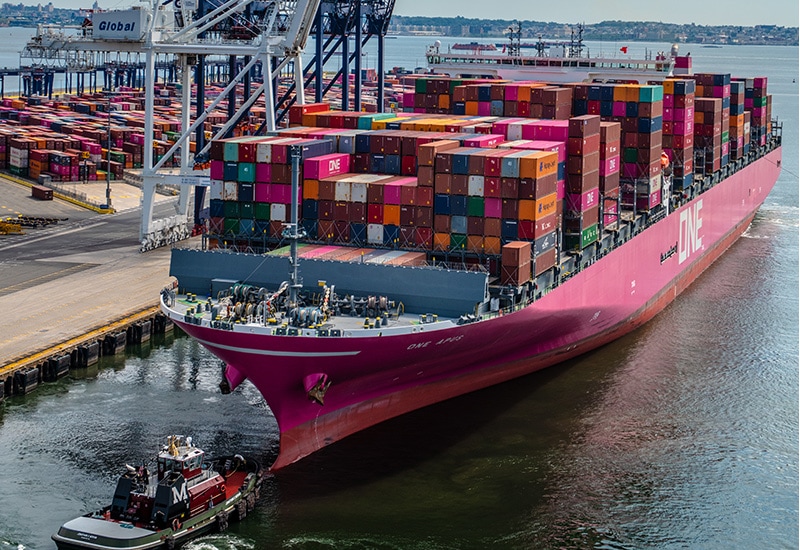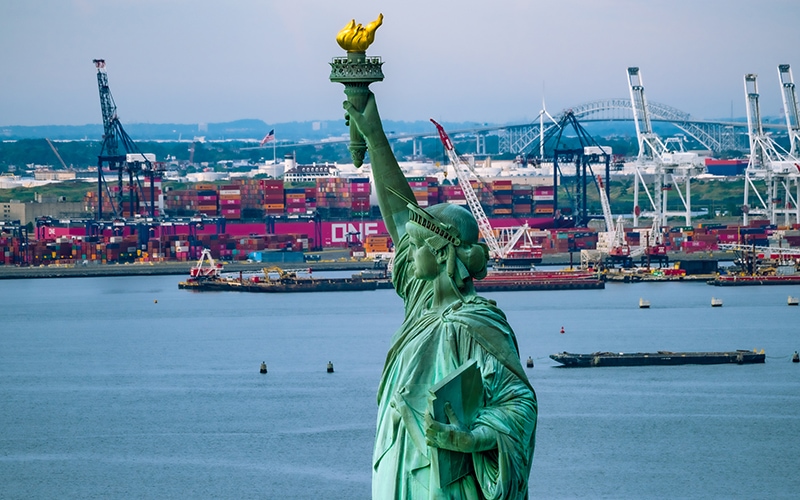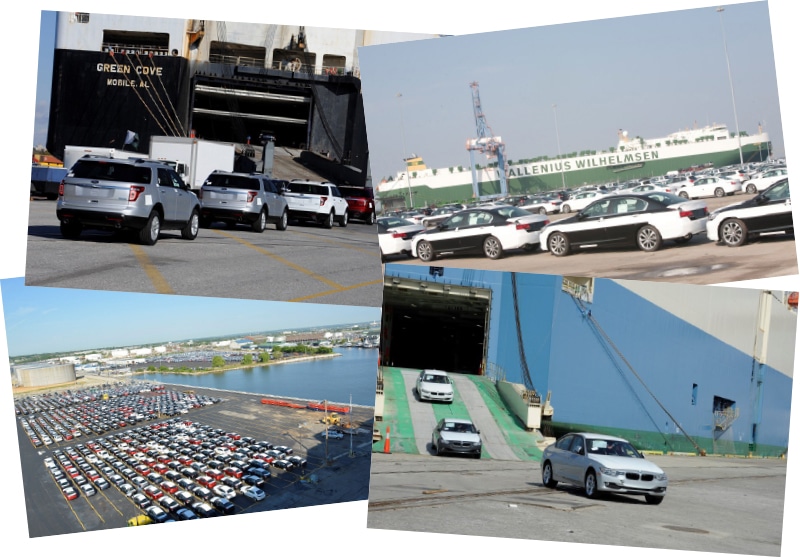Port Development Accelerates

Across the United States and much of the world, ports are preparing for a changing future. These leading U.S. ports are upgrading their infrastructure and expanding their cargo handling capabilities.
When consumer demand skyrocketed during the pandemic, cargo volumes at many of the nation’s ports jumped ahead of projections by several years.
“The Port of New York and New Jersey saw an enormous spike in volume during the pandemic,” says Patrick Thrasher, the port’s senior program manager for capital program delivery. The port hit volume levels that had been projected for five to seven years in the future, he adds.
Across the country, employees at many ports worked tirelessly to meet the increased demand. In addition, many carriers diverted ships to less-congested ports on the Gulf and East Coasts, or deployed smaller ships that could more easily navigate into ports, says Doug Thiessen, ports and maritime leader in the western United States for HDR, Inc., an engineering services firm.
While necessary to keep goods moving, the steps required to correct for the backlogs highlighted the aging infrastructure and lack of capacity at some ports, and the need for investments in infrastructure, technology, and environmental solutions.
“U.S. seaports need continued large capital investments in modernization to repair and replace older docks and piers, deepen channels, install larger and improved rail yards, improve electrical service, and improve landside road links,” Thiessen says.
Other needs include larger and faster cranes; electrified yard equipment; and zero-emission and autonomous street trucks.
Now, several years from the height of the pandemic, port congestion is easing and many shipping costs have dropped. While these changes sound positive, the main driver is weaker consumer demand, says Edward Hertzman, CEO of Hertzman Global Ventures, a supply chain intelligence and solutions firm.
Some investments to address the recent challenges have begun. “Almost all ports are making some type of investment in improvement,” says Spencer Shute, principal consultant with Proxima, a supply chain consultancy.
Targeting Efficiency and Visibility
“Everybody is aiming to become more efficient,” Shute says, adding that automation allows ports to respond more nimbly as demand shifts without jeopardizing safety.
Investments in connections to rail service remain critical in many West Coast ports, says Kenneth Cochran, managing director in the consumer and retail group of Alvarez and Marsal, a global professional services firm.
Continuing investments in chassis management and repair services are also a focus, as chassis availability remains a key constraint. Overall investment in automation in the United States still lags the rest of the globe due to resistance by some labor groups, Cochran adds.
Although still nascent, the growing preference for East Coast ports by many carriers highlights the importance of a diversified supply chain, not just overseas at the factory level, but locally at the port level. “Diversification will be part of the go-forward strategy for most organizations,” Hertzman says.
As ports consider their capital needs, part of their funding may come in the form of federal dollars from programs like the National Infrastructure Project Assistance (Mega) program.
This program “supports large, complex projects that are difficult to fund by other means and are likely to generate national or regional economic, mobility, or safety benefits,” according to the U.S. Department of Transportation (DOT). Eligible projects are of national or regional significance, and could include bridges, ports, and other structures.
Both private and public sectors also are investing in advanced data capabilities and platforms. The goal? “To provide real-time visibility for ports, shippers, freight forwarders, brands, and retailers so everyone knows exactly where the goods are and how to plan accordingly,” Hertzman says.
The Freight Logistics Optimization Works (FLOW), which launched in March, is an effort by the White House and multiple supply chain companies to develop a digital tool that provides information on the condition of a node or region in the supply chain.
Through the FLOW pilot, the DOT acts as an independent steward of supply chain data across shipping lines, ports, terminal operators, truckers, railroads, warehouses, and beneficial cargo owners. With this information, participants can make more informed supply chain decisions.
Addressing Environmental Concerns
Along with efficiency, port investments are addressing environmental concerns and climate change. Numerous electric vehicle (EV) demonstration projects are underway, with a goal of cutting emissions from port facilities and the transportation options serving ports.
In addition, greater use of intermodal rail can cut emissions while helping to address the truck driver shortage.
Hertzman recommends monitoring California and the California Air Resources Board (CARB).
“Companies will have to be CARB compliant in the years to come,” Hertzman predicts, adding that he believes other states will mirror their regulations.
In 2020, for instance, CARB approved a new regulation that builds on the At-Berth Regulation adopted in 2007, adding new vessel categories that will be required to control pollution when they run auxiliary engines or boilers while docked.
California isn’t alone in tightening environmental regulations. “It’s worth noting the investment the Port of Shanghai is making in carbon emissions,” Hertzman says, adding these investments likely are attempts to get ahead of expected requirements from importers, retailers, and brands.
In short, ports are preparing for a changing future. “Port infrastructure projects take years to plan, design, fund, and construct,” Thiessen says. “Planning ahead with ports and marine terminals to ensure modern, cost-effective facilities are available to handle your cargo is important.”

The Port of New York and New Jersey saw cargo volume hit nearly 9.5 million twenty-foot equivalent units (TEUs) in 2022, up 5.7% from 2021. That moves the port into second place in national port rankings, behind the Port of Los Angeles.
Port Authority of New York and New Jersey
Building 21st Century Infrastructure While Keeping the Region Moving
Cargo volume at the Port of New York and New Jersey hit nearly 9.5 million twenty-foot equivalent units (TEUs) in 2022, up 5.7% from 2021. That was enough to move the port into second place in national port rankings, behind the Port of Los Angeles.
Helping to speed movement of the growing number of goods arriving at the Port of New York and New Jersey is a range of equipment, including six state-of-the-art container terminals that can handle nine 14,000 TEU-capacity vessels at the same time, one billion square feet of warehousing and distribution space within 50 miles of the port, and an ExpressRail intermodal network with an annual lift capacity of 1.5 million containers.
At the same time, the seaport continues to add to its capabilities, improving infrastructure and driving toward its climate goals.
The pandemic, for all the financial and human misery it wrought, also provided “a real snapshot of the demand to come,” Thrasher says.
The seaport’s leadership gained a solid idea of the investments needed to meet expected growth in cargo volume over the next 15 or 20 years, he adds. One example is the $220-million Port Street Corridor Improvement Project, slated for completion in mid-2028. This will modernize one of two main highway interchanges into the complex and provide easier access to the New Jersey highway system—a key feature for the approximately 60,000 to 80,000 trucks that serve the port weekly.
In addition, a freight rail line that runs through the interchange, providing service to the northern portion of Port Newark, will be elevated in order to mitigate flooding.
The work will occur while maintaining adequate service levels for the trucks currently traveling to and from the port. “Much of the complexity and cost of the project comes not from the concrete and the steel, but from managing around operations,” Thrasher adds.
Meeting Climate Goals
The Port Authority of New York and New Jersey, a signatory to the Paris climate accords, has been aggressive in reducing greenhouse gas emissions from the bistate agency’s own operations, as well as those of its users, Thrasher says.
The installation of four direct current (DC) fast chargers at the Truck Welcome Center will help the port drive toward that policy goal, as truck emissions account for about half of the port’s Scope 3 emissions. (Scope 3 emissions are those from the port’s users.)
“The chargers are forward-looking and part of modernizing our legacy infrastructure to today’s standards,” Thrasher says. The project is expected to be completed in 2024.
Multiple other projects are in the planning stages. One is the Port Authority’s southbound connector intermodal project, which will enable trains heading into the ExpressRail Elizabeth facility to exit and enter to the south; currently, freight trains can only enter and exit to the north.
“This will add fluidity and flexibility to that part of the network,” Thrasher says.
The Port Authority also is partnering with the U.S. Army Corps of Engineers to deepen the federal navigational channels into the port from 50 to 55 feet in most areas, and to 58 feet in one channel, as well as to widen the channels at key points.
The project will improve safety and efficiency for vessels currently calling the port and is designed to accommodate vessels with a capacity of up to 18,000 TEUs, allowing them to efficiently navigate to and from the port. Planning is currently underway; the work itself will take about 15 years.
As important as these and other projects are to the port’s continued success, close collaboration and coordination among all stakeholders remain just as critical. “It’s what makes the infrastructure work,” Thrasher says.

The Port of Baltimore handles the majority of the East Coast market’s share of roll on/roll off (Ro/Ro) cargo annually. The port is refurbishing its Ro/Ro berths to better accommodate today’s larger and heavier pieces of Ro/Ro equipment. Photos by Bill McAllen.
Maryland Port Administration
Building on Centuries of Serving Shippers
Some ports measure their history in decades. The Port of Baltimore, which is managed by the Maryland Port Administration, can look back centuries. It started in the 17th century as an access point for Maryland’s tobacco trade with England. It was designated a port of entry by the General Assembly in 1706.
In the decades since, the port has continued to grow. In 2022, it handled a record $74.3 billion worth of foreign cargo.
To ensure it can continue to serve shippers for centuries to come, the Port of Baltimore continues to invest in its infrastructure and operations. Among the most significant projects are these:
• The Howard Street Tunnel (HST) Project. This project will improve vertical clearance along CSX’s I-95 Rail Corridor, enabling double-stack trains to travel between Baltimore City, Maryland, and Philadelphia, Pennsylvania, and providing the East Coast with seamless double-stack capacity from Maine to Florida, as well as the ability to send double-stacked containers by rail into the Ohio Valley and on to Chicago.
The Howard Street Tunnel, a 1.7-mile-long railroad passage under the heart of Baltimore City, was constructed in 1895. Its vertical clearance is up to 18 inches less than the 21 feet necessary for double-stack trains, making it one obstacle restricting the ability of these trains to move along this section of the CSX network.
The HST Project, which is underway and slated for completion in 2026, will eliminate the remaining double-stack obstructions in Maryland, Delaware, and Pennsylvania between Baltimore City and Philadelphia. It’s expected to increase the port’s business by about 160,000 containers annually, generating about 6,550 construction jobs and an additional 7,300 jobs from increased business.
• Mid-Chesapeake Bay Restoration Project. To maintain the depths and widths needed for safe navigation, the U.S. Army Corps of Engineers annually dredges nearly 5 million cubic yards of material from the channels and anchorages serving the Port of Baltimore. Once the material is removed, it needs to be contained or disposed of in an environmentally conscious manner.
This project will reuse dredged material to help rebuild James and Barren islands, restore coastal shorelines, and provide a long-term placement site for dredged material.
It also will restore 2,072 acres of lost remote island habitat on James Island and 72 acres of remote island habitat on Barren Island.
• Rail Capacity Modernization Project. This project will reconstruct and update the Seagirt Marine Terminal’s intermodal rail yard infrastructure to support increased demand for double-stacked trains of containerized cargo.
Along with providing more seamless and efficient rail operations, these updates will improve air quality around the port by increasing rail usage and converting existing diesel-fueled rail yard operation to electrified equipment.
Additional rail usage will also help alleviate ongoing logistical bottlenecks on major interstate highways.
Scheduled for completion in 2025, the project includes the building of four new rail tracks totaling 17,670 track feet, as well as two crane rail beams totaling 7,000 linear feet within the Seagirt Terminal.
• Refurbishing Roll On/Roll Off Berths. The Port of Baltimore is refurbishing its roll on/roll off (Ro/Ro) berths to better accommodate today’s larger and heavier pieces of Ro/Ro equipment, like farm and construction machinery.
“Baltimore handles more of this cargo than any other U.S. port,” says spokesperson Richard Scher. In 2022, the Port of Baltimore handled a record-setting 765,019 tons of imported Ro/Ro cargo, besting its previous record of 603,516 tons in 2019.
This is part of a larger berth reconstruction plan to address the impact of predicted climate change by including storm drain improvements and the construction of a sea curb, or short seawall that protects against sea level rise and storm surge, at the Dundalk Marine Terminal, and eventually, at each newly reconstructed berth. Dundalk will be the first terminal in the nation with this arrangement.
